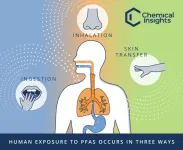(Press-News.org) Computer scientists at the University of Pennsylvania School of Engineering and Applied Science have designed a “reconstruction attack” that proves U.S. Census data is vulnerable to exposure and theft.
Aaron Roth, Henry Salvatori Professor of Computer & Cognitive Science in Computer and Information Science (CIS), and Michael Kearns, National Center Professor of Management & Technology in CIS, led a recent PNAS study demonstrating that statistics released by the U.S. Census Bureau can be reverse engineered to reveal protected information about individual respondents. With computing power no stronger than that of a commercial laptop and algorithm design drawn from machine learning fundamentals, the research team established risks to the privacy of the U.S. population.
The study stands out for being the first of its kind to determine a baseline for unacceptable susceptibility to exposure. In addition, it proves that an attack has the means to ascertain the likelihood that a reconstructed record corresponds to the data of a real person, making it even more probable that this kind of attack could render respondents vulnerable to identity theft or discrimination.
The findings sharpen the stakes of one of the digital era’s most significant debates in public policy.
“Over the last two decades it has become clear that practices in widespread use for data privacy — anonymizing or masking records, coarsening granular responses or aggregating individual data into large-scale statistics — do not work,” says Kearns. “In response, computer scientists have created techniques to provably guarantee privacy.”
“The private sector,” adds Roth, “has been applying these techniques for years. But the Census’ long-running statistical programs and policies have additional complications attached.”
For example, the Census is constitutionally mandated to carry out a full population survey every ten years. This data is used for key political, economic and social functions: apportioning House seats, drawing district boundaries, determining federal funding amounts for state and local uses, financing disaster relief, welfare programs, infrastructural expansion and more. The data also provides vital tools for demographic researchers in government and academia.
While Census information is public, strict laws govern the privacy of individual data. To this end, publicly available statistics aggregate each respondent’s survey answers, reflecting the population with mathematical precision without directly revealing individuals’ personal information.
The problem is that these aggregated statistics are a lock that can be picked, and all it takes are the right tools. Attackers can use these aggregates to reverse engineer sets of records consistent with confirmed statistics, a process known as “reconstruction.”
In response to these risks, the Census ran its own internal reconstruction attack between the 2010 and 2020 surveys to gauge the need for a change in reporting. The findings merited a Census overhaul of confidentiality measures, and a decision to implement a provable protection technique known as “differential privacy.”
Differential privacy conceals individual data while maintaining the integrity of the larger data set. Cynthia Dwork, Gordon McKay Professor of Computer Science at Harvard University and Roth and Kearns’ collaborator on the study, co-invented the technique in 2006. Dwork’s work is significant for being the first to provide “privacy” with a mathematically rigorous definition.
Rather than report statistics that transparently reflect true responses, differential privacy introduces strategic amounts of false data, known as “noise,” which consists of randomly generated positive or negative numbers averaging out to roughly zero. At large scales, the noise’s interference in statistical correctness is negligible. But complications do arise in demographic statistics describing small populations, where noise has a relatively larger effect on reporting.
The trade-off between accuracy and privacy is complex.
Certain social scientists have argued that the Census practice of publishing aggregate statistics poses no inherent risk. While acknowledging that individual records are susceptible to reconstruction through educated guessing or comparison with public documentation, this camp maintains that the Census’ decision to implement differential privacy is a poor one, claiming the success rate for reconstructing individual records is no better than random chance.
But Roth and Kearns’ work has proven otherwise, running queries that function like Venn diagrams with hundreds of thousands of overlapping ovals. These overlaps signal the likelihood of accuracy in possible data configurations that match publicly available statistics, allowing for attackers to outperform any possible baseline for random chance.
“What’s novel about our approach is that we show that it’s possible to identify which reconstructed records are most likely to match the answers of a real person,” says Kearns. “Others have already demonstrated it’s possible generate real records, but we are the first to establish a hierarchy that would allow attackers to, for example, prioritize candidates for identity theft by the likelihood their records are correct.”
On the matter of complications posed by adding error to statistics that play such a significant role in the lives of the U.S. population, the researchers are realistic.
“The Census is still working out how much noise will be useful and fair in order to balance the trade-off between accuracy and privacy. And, in the long run, it may be that public policymakers decide that the risks posed by non-noisy statistics are worth the transparency,” says Roth.
But when it comes to absolute guarantees for individual data protection, Roth and Kearns both affirm beyond a doubt: “Differential privacy is the only game in town.”
END
US Census data vulnerable to attack without enhanced privacy measures
Computer scientists affirm the need for “differential privacy” to protect personal data
2023-02-21
ELSE PRESS RELEASES FROM THIS DATE:
Excess nutrients lead to dramatic ecosystem changes in Cape Cod’s Waquoit Bay; the bay is a harbinger for estuaries worldwide, say researchers
2023-02-21
Woods Hole, Mass. (Feb. 21, 2023) -- When the Covid-19 pandemic hit in 2020 with associated travel restrictions, Matthew Long thought his students could shift their overseas research projects to instead study the seagrass meadow ecosystem in Waquoit Bay. It’s a shallow, micro-tidal estuary on the south side of Cape Cod in Massachusetts, near the Woods Hole Oceanographic Institution (WHOI) where Long is an associate scientist in the Marine Chemistry and Geochemistry Department.
However, when Long and his students looked for seagrass meadows where he had seen them in previous years, there were only a few shoots of dying Zostera marina eelgrass, ...
New AGA guideline recommends blood and stool tests for monitoring ulcerative colitis
2023-02-21
Bethesda, MD (Feb. 21, 2023) — In new evidence-based guidelines, the American Gastroenterological Association (AGA) recommends non-invasive biomarkers as a first-line strategy for monitoring many patients with ulcerative colitis (UC). These guidelines were published today in Gastroenterology.
The AGA guidelines outline use cases for three biomarkers that provide accurate insights into ulcerative colitis disease activity: serum C-reactive protein (CRP) (blood), fecal calprotectin (stool) and fecal lactoferrin (stool).
“For decades we have regarded endoscopy as the gold ...
RIT researcher awarded NSF CAREER funding to develop advanced computer memory and devices
2023-02-21
Kai Ni was awarded a National Science Foundation CAREER Award to improve computing memory through the use of ferroelectric materials and capacity.
The assistant professor of electrical and microelectronic engineering in RIT’s Kate Gleason College of Engineering, Ni has been at the forefront of advancing ferroelectric memory, a familiar but never widely adopted technology that has the potential to meet the growing demand for more energy-efficient computing performance.
“The appetite for semiconductors just keeps growing. With the data we are generating every day, we need ways to process ...
CHOP researchers develop first effective preclinical models for most common genetic cause of Leigh Syndrome
2023-02-21
Philadelphia, February 21, 2023 – Researchers from Children’s Hospital of Philadelphia (CHOP) developed two new zebrafish models for studying a specific genetic form of mitochondrial disease that represents the most common cause of Leigh syndrome. Using these models, the team identified two drugs already approved by the Food and Drug Administration (FDA) for other conditions that could be repurposed to treat this specific cause of Leigh syndrome. The findings were recently published in the journal Human Molecular Genetics.
SURF1 deficiency ...
Public lecture: how can we have a good future with artificial intelligence?
2023-02-21
Public lecture: how can we have a good future with artificial intelligence?AI expert and educator Professor Anikó Ekárt to discuss one of today’s most provocative topics
Lecture will take place on 28 February at Aston University
Talk to explore artificial intelligence’s capabilities, benefits and pitfalls.
The potential impact of artificial intelligence (AI) on our daily lives will be explored in a public lecture at Aston University.
The University is inviting the public onto its campus on Tuesday 28 February to hear Professor ...
Study finds parents serve as a safety net as grown kids navigate the workforce
2023-02-21
A new study underscores the role that parents play as a safety net for their young adult children as those children navigate the labor market, and highlights the challenges facing young adults who do not have access to parental support.
“In recent decades, we’ve seen a lot of changes in the labor market, from the decline of lifetime employment at one job to the rise of the so-called ‘gig economy,’” says Anna Manzoni, corresponding author of the study and an associate professor of sociology at North Carolina State University. “We wanted to see what role ...
Noble false widow spider found preying on pygmy shrew
2023-02-21
Scientists at University of Galway have published the first record of a noble false widow spider feeding on a pygmy shrew, a species of tiny mammal protected in Ireland.
The new study, recently published in the international journal Ecosphere, demonstrates further the potentially negative impact of the invasive and venomous noble false widow spider on native species.
A recording by Dawn Sturgess showing the spider interacting with the pygmy shrew be downloaded at https://bit.ly/3XPbDKU.
It is the first time a member of this family of spiders, ...
Starch gelatinization, retrogradation, and the world’s fluffiest white bread (video)
2023-02-21
WASHINGTON, Feb. 21, 2023 — If you want to make the fluffiest bread possible, you’re going to need to use chemistry. This week, we explore the science behind starch gelatinization, a phenomenon found in Chinese “tangzhong” and Japanese “yudane” techniques. Then, we put it to the test to see how much gelatinized starch it takes to make the fluffiest, tastiest and most stale-resistant loaf! https://youtu.be/3ziMBDPMuP8
Reactions is a video series produced by the American Chemical Society and PBS Digital Studios. Subscribe to ...
Chemical Insights Research Institute and Emory University’s Rollins School of Public Health team to study the human health impact of PFAS chemical exposure
2023-02-21
ATLANTA – Feb. 21, 2023 – Chemical Insights Research Institute (CIRI) of UL Research Institutes and Emory University's Rollins School of Public Health have announced upcoming research to study human exposure to per- and polyfluoroalkyl substances (PFAS). Data from the Centers for Disease Control and Prevention (CDC) show that approximately 97% of Americans have detectable PFAS levels in their blood. The joint study aims to understand how this exposure occurs and the potential health consequences.
Although humans may be exposed to PFAS by ingesting food or ...
These sports sensors could curb ‘bad calls’ and help players during practices
2023-02-21
If you watched the most recent Super Bowl, you know the importance of a referee’s call on the outcome of a game. Slow-motion replays and close-watching eyes help, but a new sensor technology could someday serve as an even more reliable tool for officials. Researchers reporting in ACS Applied Nano Materials have developed a self-powered, hybrid nanogenerator sensor that could help make more accurate calls and allow boxers and cricket players to practice more efficiently.
As sensors become less complicated and more ubiquitous, their applications have stretched into the world of sports, ...
LAST 30 PRESS RELEASES:
Stardust study resets how life’s atoms spread through space
Practical education: Clinical scenario-based program development
The impact of family dynamics on eating behaviour – how going home for Christmas can change how you eat
Tracing the quick synthesis of an industrially important catalyst
New software sheds light on cancer’s hidden genetic networks
UT Health San Antonio awarded $3 million in CPRIT grants to bolster cancer research and prevention efforts in South Texas
Third symposium spotlights global challenge of new contaminants in China’s fight against pollution
From straw to soil harmony: International team reveals how biochar supercharges carbon-smart farming
Myeloma: How AI is redrawing the map of cancer care
Manhattan E. Charurat, Ph.D., MHS invested as the Homer and Martha Gudelsky Distinguished Professor in Medicine at the University of Maryland School of Medicine
Insilico Medicine’s Pharma.AI Q4 Winter Launch Recap: Revolutionizing drug discovery with cutting-edge AI innovations, accelerating the path to pharmaceutical superintelligence
Nanoplastics have diet-dependent impacts on digestive system health
Brain neuron death occurs throughout life and increases with age, a natural human protein drug may halt neuron death in Alzheimer’s disease
SPIE and CLP announce the recipients of the 2025 Advanced Photonics Young Innovator Award
Lessons from the Caldor Fire’s Christmas Valley ‘Miracle’
Ant societies rose by trading individual protection for collective power
Research reveals how ancient viral DNA shapes early embryonic development
A molecular gatekeeper that controls protein synthesis
New ‘cloaking device’ concept to shield sensitive tech from magnetic fields
Researchers show impact of mountain building and climate change on alpine biodiversity
Study models the transition from Neanderthals to modern humans in Europe
University of Phoenix College of Doctoral Studies releases white paper on AI-driven skilling to reduce burnout and restore worker autonomy
AIs fail at the game of visual “telephone”
The levers for a sustainable food system
Potential changes in US homelessness by ending federal support for housing first programs
Vulnerability of large language models to prompt injection when providing medical advice
Researchers develop new system for high-energy-density, long-life, multi-electron transfer bromine-based flow batteries
Ending federal support for housing first programs could increase U.S. homelessness by 5% in one year, new JAMA study finds
New research uncovers molecular ‘safety switch’ shielding cancers from immune attack
Bacteria resisting viral infection can still sink carbon to ocean floor
[Press-News.org] US Census data vulnerable to attack without enhanced privacy measuresComputer scientists affirm the need for “differential privacy” to protect personal data





